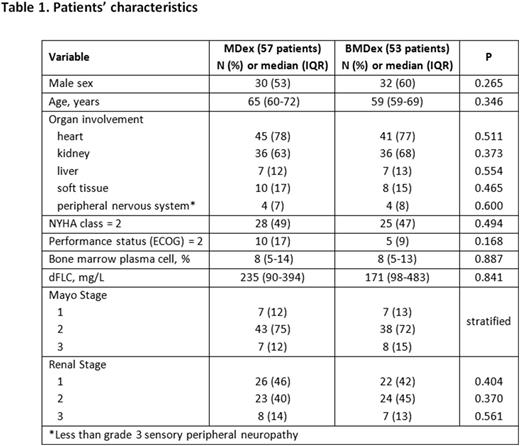Abstract

Background. Current upfront treatment of light chain (AL) amyloidosis is often based on bortezomib in patients. However, data on the safety and efficacy of bortezomib in this setting mostly derive from uncontrolled, retrospective series, that are difficult to compare due to different proportion of patients with advanced disease. Here we report the analysis of a multicenter randomized phase III trial comparing MDex, a current standard of care, and MDex with the addition of bortezomib (BMDex) in newly-diagnosed AL amyloidosis that was performed in Europe and Australia (EMN-03 study, NCT01277016).
Patients and Methods. Main eligibility criteria included measurable disease (M-protein >10 g/L or dFLC >50 mg/L), estimated glomerular filtration rate (eGFR) ³30 mL/min, and adequate liver function. Previously treated patients, those who had >30% bone marrow plasma cell or lytic bone lesions, NYHA class >II heart failure, grade 3 sensory or grade 1 painful peripheral neuropathy, or ECOG performance status >2 were excluded. In January 2013 the protocol was amended to include Mayo stage III patients, provided their NT-proBNP was <8500 ng/L (stage IIIa). Patients were randomized to receive either MDex (melphalan at 0.22 mg/kg and dexamethasone at 40 mg daily for 4 consecutive days every 28 days) or BMDex (bortezomib added at 1.3 mg/m2, on days 1, 4, 8, and 11 in cycles 1 and 2, and on days 1, 8, 15, and 22 in the following cycles). The primary endpoint was overall hematologic response at 3 months. Treatment was continued until completion of MDex cycle 9 or BMDex cycle 8, or achievement of CR or of at least partial response (PR) plus organ response after cycle 6, and was discontinued in case PR was not achieved by cycle 3. Enrollment is now completed (110 patients) with the last patient enrolled in February 2016 (database lock: July 25, 2016).
Results. Patients' characteristics are reported in the Table. The proportion of patients experiencing at least 1 grade 3-4 severe adverse events (SAE) was similar in the MDex and BMDex arms (49% vs. 60%, P=0.11). The total number of reported adverse events per cycle was lower in the MDex group (10% vs 23%, P<0.01). Most common SAEs (MDex vs. BMDex) were cytopenia (4% vs. 7%, P=0.04), fluid retention (3% vs. 6%, P=0.02), and neuropathy (0 vs. 2%, P<0.01). One patient died within 3 months in the MDex arm and 3 in the BMDex group (P=0.28). Response was evaluated by intent to treat. Hematologic response rates after cycle 3 were 51% and 78% (P=0.001), with 28% and 53% complete response (CR) /very good partial response (VGPR) (P=0.003), in the MDex and BMDex arms, respectively. Overall hematologic response at the end of treatment, after a median of 5 cycles, was 56% and 81% (P=0.001), with 38% and 64% CR/VGPR in the MDex and BMDex arms, respectively (P=0.002). Cardiac response was reached in 8 of 33 evaluable patients treated with MDex (24%) and 10 of 26 (38%) who received BMDex (P=0.119). Renal response was attained in 17 of 35 patients (48%) in both arms. However, there was a higher proportion of cardiac progression in the MDex arm with borderline statistical significance (32% vs. 15%, P=0.054). After a median follow-up of living patients of 25 months, 26 patients (24%) died, 16 in the MDex arm and 10 in the BMDex arm with no significant difference in survival (Figure 1a). Achievement of hematologic and cardiac response at 3 months significantly improved survival (Figures 1b and 1c).
Conclusion. This is the first prospective randomized trial of novel agents in AL amyloidosis. The criteria of hematologic and cardiac response are validated in the prospective setting for the first time. The primary endpoint, hematologic response at 3 months has been reached, showing more frequent and more profound hematologic responses with BMDex, preventing progression of cardiac dysfunction, with a modest increase in toxicity. This regimen can be proposed as a new standard of care in AL amyloidosis.
We would like to acknowledge the European Myeloma Network, the Australasian Leukaemia and Lymphoma Group and the Leukaemia Foundation of Australia for their ongoing support, and Janssen-Cilag for partially funding the trial and providing the study drug.
Kastritis:Genesis: Consultancy, Honoraria; Takeda: Consultancy, Honoraria; Janssen: Consultancy, Honoraria; Amgen: Consultancy, Honoraria. Cibeira:Janssen: Honoraria; Celgene: Honoraria. Mollee:Celgene: Membership on an entity's Board of Directors or advisory committees, Research Funding; Janssen: Membership on an entity's Board of Directors or advisory committees, Research Funding; Amgen: Membership on an entity's Board of Directors or advisory committees; Bristol-Myers Squibb: Membership on an entity's Board of Directors or advisory committees; Nilelse: Research Funding. Hajek:Takeda: Honoraria, Membership on an entity's Board of Directors or advisory committees. Moreau:Janssen: Honoraria, Speakers Bureau; Celgene: Honoraria; Novartis: Honoraria; Amgen: Honoraria; Takeda: Honoraria; Bristol-Myers Squibb: Honoraria. Mateos:Janssen, Celgene, Amgen, Takeda, BMS: Honoraria. Wechalekar:Takeda: Honoraria; Janssen: Honoraria; Glaxo Smith Kline: Honoraria; Celgene: Honoraria. Dimopoulos:Amgen: Consultancy, Honoraria, Membership on an entity's Board of Directors or advisory committees; Genesis: Consultancy, Honoraria; Janssen: Consultancy, Honoraria, Membership on an entity's Board of Directors or advisory committees; Novartis: Consultancy, Honoraria, Membership on an entity's Board of Directors or advisory committees; Celgene: Consultancy, Honoraria, Membership on an entity's Board of Directors or advisory committees. Palumbo:Janssen Cilag: Honoraria; Takeda: Employment, Honoraria. Sonneveld:Amgen: Consultancy, Honoraria, Research Funding; Janssen: Consultancy, Honoraria, Research Funding; Celgene: Honoraria, Research Funding; Takeda: Consultancy, Honoraria; Karyopharm: Consultancy, Honoraria, Research Funding. Merlini:Pfizer: Honoraria, Speakers Bureau; Millennium Takeda: Consultancy; Prothena: Honoraria; GlaxoSmithKline: Consultancy. Palladini:Prothena: Honoraria.
Author notes
Asterisk with author names denotes non-ASH members.

This icon denotes a clinically relevant abstract



This feature is available to Subscribers Only
Sign In or Create an Account Close Modal